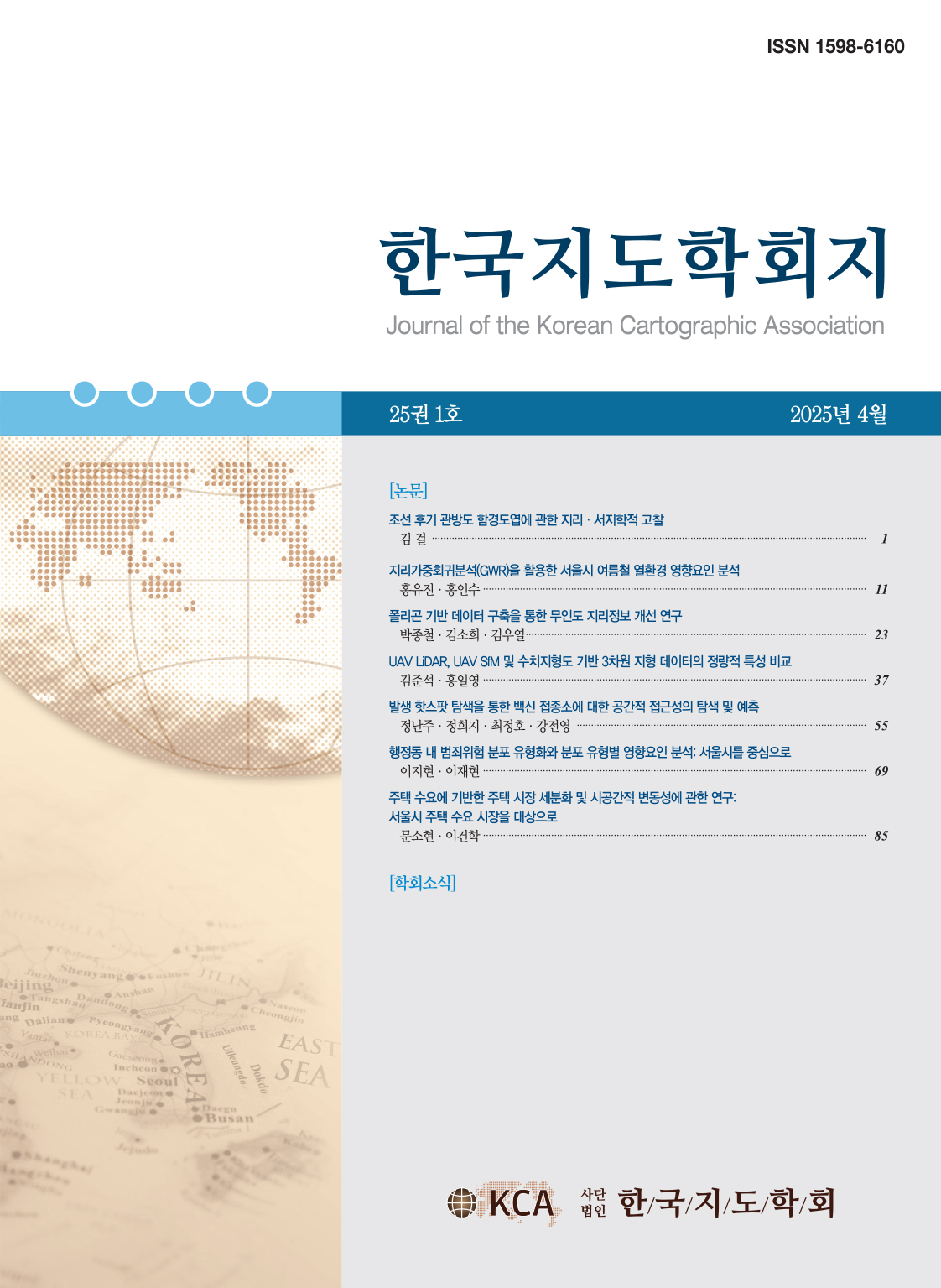Research Article
Abstract
References
Information
Smart-card data is a high quality data that can be used in analyzing urban flow patterns. However, due to methodological difficulties of flow clustering, earlier studies have not been able to take full advantage of the smart-card data. To overcome this limitation, this study introduces an efficient flow cluster detection method based on smart-card data of public transportation and applies it to public transit trips in Seoul to derive significant flow clusters of trips. As a result of case study, we identified various clusters of public trasit trips in Seoul and could detect significant clusters that are composed of several individual travel flows being adjacent in space but mostly out of different transport modes and routes. Furthermore, the methodology of this study made it possible to capture the major travel flow patterns. They have not been recognized as important flow patterns in a normal way, but they have significant traffic volume when gathered into a flow cluster. This study provides important methodological implications to the analysis of flow patterns, and the suggested algorithm is expected to be the basis of more advanced flow clustering techniques in the future.
교통카드 데이터는 도시 유동 패턴 분석을 가능하게 하는 양질의 대용량 데이터를 제공한다. 하지만 유동 클러스터링의 방법론적 어려움으로 인해 기존의 연구들은 데이터의 이점을 최대로 활용하지 못하고 있다. 이러한 한계를 극복하고자, 본 연구는 교통카드 데이터에 기반한 효율적인 유동 클러스터 탐지 기법을 제시하고, 이를 서울시 대중교통 통행 데이터에 적용하여 유의미한 유동 통행 클러스터를 도출하고자 한다. 사례 분석 결과, 서울 전체에 걸쳐 있는 다양한 대중교통 통행 클러스터를 도출할 수 있었고, 특히 공간상에서는 인접하지만 서로 다른 교통수단과 노선 하에서 이루어진 개별 유동들을 하나의 유동 통행 패턴으로 탐지할 수 있었다, 더 나아가, 일반적인 빈도분석으로는 뚜렷하게 나타나지 않지만 공간적으로 인접한 여러 다발의 유동이 모였을 때 유의미한 통행량을 가지게 되는 주요 통행 패턴을 포착할 수 있었다. 본 연구는 유동 현상을 분석하는데 중요한 방법론적 시사점을 제시하고 있으며, 제시된 알고리즘은 향후 보다 진보된 유동 클러스터링 기법을 개발하는데 필요한 기초 결과로 활용될 수 있을 것으로 기대된다.
- 고준호, 2015, "서울시 경전철 민간투자사업을 통한 취약지역 개선," 서울정책아카이브.
- 김관호・오규협・이영규・정재윤, 2013, "스마트카드 빅데이터를 이용한 서울시 지하철 이동패턴 분석," 한국전자거래학회지, 18(3), 211-222. 10.7838/jsebs.2013.18.3.211
- 김남주, 2012, "도보접근거리분포 및 주택가격변화에 따른 지하철 역세권의 범위 설정에 관한 연구: 중앙선 구리, 남양주시 지하철역을 대상으로," 국토계획, 47(6), 29-38.
- 김대웅・유영근・최한규, 2002, "지하철 도보역세권 설정방법과 적용에 관한 연구," 국토계획, 37(5), 177-186.
- 김민주・이영인, 2017, "스마트카드 데이터를 이용한 심야버스 이용수요 특성분석: 강남역을 중심으로," 한국 ITS 학회논문지, 16(1), 101-116.
- 김순관・김원호・이신해・권순실・최선희・전재현, 2011, 「교통카드 데이터를 활용한 대중교통 통합OD 구축 및 활용방안 연구」, 서울시정개발연구원.
- 김순관, 2015, "교통카드 데이터 활용도 제고방안," 국토, 405, 18-24.
- 김인・박수진, 2011, 「도시해석」, 푸른길.
- 김지우・이건학, 2017, "웹기반 데이터 시각화 도구를 활용한 플로우 데이터의 지리적 시각화 기법 탐색," 한국지도학회지, 17(1), 25-39. 10.16879/jkca.2017.17.1.025
- 김태호・이용택・황의표・원제무, 2008, "CART 분석을 이용한 신도시지역의 지하철 역세권 설정에 관한 연구," 한국철도학회 논문집, 11(3), 216-224.
- 박종수・이금숙, 2008, "서울 대도시권 지하철망의 구조적 특성 분석," 한국경제지리학회지, 11(3), 2008, 459-475.
- 성현곤・김태현, 2005, "서울시 역세권의 유형화에 관한 연구," 대한교통학회 학술대회 논문집, 49, 455-464.
- 신임호・이주형, 2012, "서울시 지하철 유동인구 이동패턴 분석을 통한 중심지역 및 특성 분석," 디자인융복합연구, 11(2), 43-55.
- 이금숙・박종수, 2006, "서울시 대중교통 이용자의 통행패턴 분석," 한국경제지리학회지, 9(3), 379-395.
- 이금숙・김호성・박종수, 2017, "서울 대도시권 지하철 통행흐름의 요일 간 변이성 분석: 동적 시각화방법을 토대로," 한국경제지리학회지, 20(2), 158-172. 10.23841/egsk.2017.20.2.158
- 조대헌, 2011, "유동 패턴 분석 방법으로서의 요인 분석에 대한 비판적 검토," 한국지도학회지, 11(1), 33-46.
- 한상욱・강희용・이명훈, 2015, "교통카드 데이터를 활용한 주요 역세권별 대중교통 이용 통근통행자의 주거지 분포: 수도권을 대상으로," 국토계획, 50(4), 103-117.
- 한수경・이희연, 2015, "서울대도시권 고령자의 시간대별 대중교통 통행흐름 특성과 통행 목적지 유인 요인 분석," 서울도시연구, 16(2), 183-201.
- Andrienko, N. and Andrienko, G., 2010, Spatial generalization and aggregation of massive movement data,
IEEE Transactions on Visualization and Computer Graphics , 17(2), 205-219. 10.1109/TVCG.2010.44 21149876 - Berglund, S. and Karlström, A., 1999, Identifying local spatial association in flow data,
Journal of Geographical Systems , 1(3), 219-236. 10.1007/s101090050013 - Cui, W., Zhou, H., Qu, H., Wong, P. C., and Li, X., 2008, Geometry-based edge clustering for graph visualization,
IEEE Transactions on Visualization and Computer Graphics , 14(6), 1277-1284. 10.1109/TVCG.2008.135 18988974 - Lee, G., 2008, An alternative method for assessing local spatial association among inter-paired location events: Vector spatial autocorrelation in housing transactions,
Journal of the Economic Geographical Society of Korea , 11(4), 564-579 10.23841/egsk.2008.11.4.564 - Liu, Y., Tong, D., and Liu, X., 2015, Measuring spatial autocorrelation of vectors,
Geographical Analysis , 47(3), 300-319. 10.1111/gean.12069 - Lu, Y. and Thill, J. C., 2003, Assessing the cluster correspondence between paired point locations,
Geographical Analysis , 35(4), 290-309. 10.1111/j.1538-4632.2003.tb01116.x - Morency, C., Trépanier, M., and Agard, B., 2007, Measuring transit use variability with smart-card data,
Transport Policy , 14(3), 193-203. 10.1016/j.tranpol.2007.01.001 - Nasiboglu, E., Kuvvetli, U., Ozkilcik, M., and Eliiyi, U., 2012, Origin-destination matrix generation using smart card data: Case study for Izmar,
2012 IV International Conference "Problems of Cybernetics and Informatics" , Baku, 1-4. 10.1109/ICPCI.2012.6486315 - Pelletier, M. P., Trépanier, M., and Morency, C., 2011, Smart card data use in public transil: A literature review,
Transportation Research Part C: Emerging Technologies , 19(4), 557-568. 10.1016/j.trc.2010.12.003 - Tao, R. and Thill, J. C., 2016, Spatial cluster detection in spatial flow data,
Geographical Analysis , 48(4), 355-372. 10.1111/gean.12100 - Tennekes, M. and Chen, M., 2021, Design space of origin‐destination data visualization,
Computer Graphics Forum , 40(3), 323-334. 10.1111/cgf.14310 - Trépanier, M., Morency, C., and Agard, B., 2009, Calculation of transit performance measures using smartcard,
Journal of Public Transportation , 12(1), 79-96. 10.5038/2375-0901.12.1.5 - Zhu, X. and Guo, D., 2014, Mapping large spatial flow data with hierarchical clustering,
Transactions in GIS , 18(3), 421-435. 10.1111/tgis.12100
- Publisher :The Korean Cartographic Association
- Publisher(Ko) :한국지도학회
- Journal Title :Journal of the Korean Cartographic Association
- Journal Title(Ko) :한국지도학회지
- Volume : 21
- No :2
- Pages :129-144
- DOI :https://doi.org/10.16879/jkca.2021.21.2.129



 Journal of the Korean Cartographic Association
Journal of the Korean Cartographic Association





